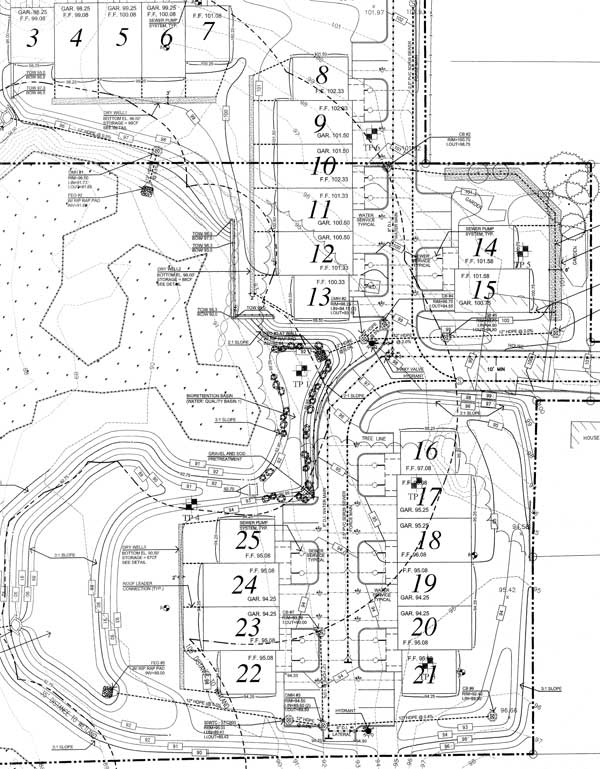At tonight’s meeting of Northampton’s Conservation Commission, the sense of the Commission was that Kohl Construction should largely leave alone the 35-foot buffer zone around the wetland behind North Street. This is likely to require a substantial redesign of Kohl’s plans, which called for encroachment as close as 12 feet. The Commission did not take a vote on the proposal, instead inviting Kohl to return to their next meeting on January 8. We’ll let you know the date and time when it’s announced.
We’ll provide a video of the December 11 hearing within a few days.
Below is the main body of the plan Kohl submitted to the Conservation Commission. Grading, walls, yards, patios, and certain components of the stormwater management system were to encroach as close as 12 feet to the wetland on the left.

See also:
Kohl Construction Applies for Special Permit and Site Plan Review
Report on Kohl’s Property by Alec MacLeod, Environmental Scientist: Indications of Vernal Pool Habitat
This site is particularly difficult to delineate, as the differences
between areas meeting the technical definitions of hydrophylic plant
communities and hydric soils are very slight over much of the site. Mr.
Dauchy and I examined literally hundreds of soil samples along all the
wetland boundaries and discussed the degree to which the soils along
the boundary either did or did not display the colors and other
features necessary to define the soil at that location as hydric.
Just Released: Planner’s Guide to Wetland Buffers for Local Governments (emphasis added)
[Environmental Law Institute:] Larger buffers will be more effective
over the long run because buffers can become
saturated with sediments and nutrients, gradually
reducing their effectiveness, and because it is much
harder to maintain the long term integrity of small buffers.
In an assessment of 21 established buffers in two
Washington counties, Cooke (1992) found that 76%
of the buffers were negatively altered over time. Buffers
of less than 50 feet were more susceptible to degradation
by human disturbance. In fact, no buffers of
25 feet or less were functioning to reduce disturbance
to the adjacent wetland. The buffers greater than 50
feet showed fewer signs of human disturbance…
Enacted local government buffer ordinances show
a wide range of wetland buffer dimensions. The lowest
we found was 15 feet measured horizontally from the
border of the wetland, with the highest approximately
350 feet. Several ordinances set 500 feet as a distance
for greater regulatory review of proposed activities, but
do not require nondisturbance at this distance. Often
the ordinances provide a range of protections, with
nondisturbance requirements nearest the wetland and
various prohibitions and limitations as the distance
from the wetland increases. Among the ordinances we
examined, the largest number of ordinances clustered
around nondisturbance or minimal disturbance buffers
of 50 feet or 100 feet, with variations (usually upward
variations) beyond these based on particular wetland
characteristics, species of concern, and to account for
areas with steeper slopes.
New Hazards Mitigation Plan Reflects Weakened Protection for Wetlands
Unfortunately, the City Council voted 7-2 in 2007 to permit development in multiple districts to encroach as close as 10 feet to wetlands. In a rapid shift of priorities, facilitating urban infill was now deemed more important than flood mitigation, water pollution control, or urban greenspace. The proposed condo development off North Street is a good example of a project that relies on the narrowed buffer zones…
The claim that allowing development within 50 feet of wetlands can
still give effective protection does not bear up under scientific
scrutiny. As Hyla Ecological Services noted in 2007:
“Buffers of less than 50 feet in width are generally
ineffective in protecting wetlands. Buffers larger than 50 feet are
necessary to protect wetlands from an influx of sediment and nutrients,
to protect wetlands from direct human disturbance, to protect sensitive
wildlife species from adverse impacts, and to protect wetlands from the
adverse effects of changes in quantity of water entering the
wetland…” (Castelle et al., ‘Wetland Buffers: Use and Effectiveness’,
1992)“Buffer function was found to be directly related to the
width of the buffer. Ninety-five percent of buffers smaller than 50
feet suffered a direct human impact within the buffer, while only 35%
of buffers wider than 50 feet suffered direct human impact. Human
impacts to the buffer zone resulted in increased impact on the wetland
by noise, physical disturbance of foraging and nesting areas, and
dumping refuse and yard waste. Overall, large buffers reduced the
degree of changes in water quality, sediment load, and the quantity of
water entering the adjacent wetland.” (Castelle et al., 1992)
…Most striking in the [Environmental Law Institute] report is that some locales desire wider
buffers in areas of intense land use to address the higher levels of
pollution and runoff. By contrast, Northampton has its narrowest
buffers in these areas.
Earlier this year, NSNA engaged Hyla to
compare Northampton’s new Wetlands Ordinance to the regulations in
other cities across Massachusetts. Hyla found that Northampton is now an outlier. In the entire state, it’s hard to find anything similar to our 10-foot buffer zones for new development…
“…it is forecasted that, Massachusetts,
and the rest of New England, is long overdue for a major hurricane to
make landfall. Based on past hurricane and tropical storm landfalls,
the frequency of tropical systems to hit the Massachusetts coastline is
an average of once out of every six years.” (Hazards Mitigation Plan, p.28)